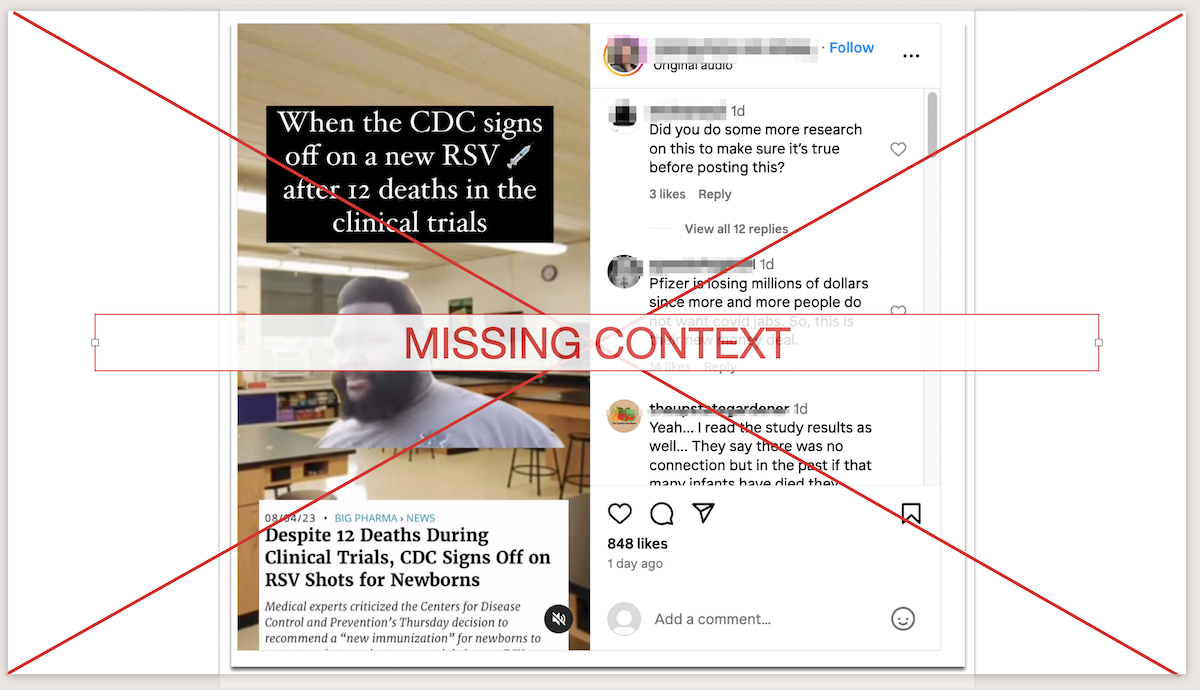Usuarios en las redes sociales afirman que en China se está inventando una enfermedad que es más mortal que el COVID-19.
“#China experimenta con una nueva cepa de #Covid que muestra ser 100% mortal”, dice una publicación en Facebook del 18 de enero.
Otra publicación en TikTok del 17 de enero similarmente dice que científicos chinos han creado una “cepa mutante de coronavirus que ataca el cerebro y tiene una probabilidad de mortalidad del 100%”.
La publicación fue marcada como parte del esfuerzo de Meta para combatir las noticias falsas y la desinformación en su plataforma. (Lea más sobre nuestra colaboración con Meta, propietaria de Facebook e Instagram).
Algunos medios de comunicación, como el New York Post, La Vanguardia y El Universal, también publicaron titulares sobre el estudio que advertía de una nueva “cepa” mortal del COVID-19.
Pero los expertos en virología, tanto los que participaron en el estudio como los independientes, afirmaron que las publicaciones en las redes sociales y los titulares de las noticias han malinterpretado los hallazgos.
Dan Wilson, biólogo molecular y divulgador científico que no participó en el estudio, afirma que el pánico que han provocado las publicaciones en las redes sociales es infundado. Wilson presenta “Debunk the Funk with Dr. Wilson”, un programa de YouTube sobre desinformación científica.
“Se trata de una investigación importante que simplemente pone de relieve las amenazas que ya existen en la naturaleza e intenta conocerlas antes de que se conviertan en un problema inmediato”, afirmó Wilson, que también es científico asociado principal en Janssen, una de las empresas farmacéuticas que desarrolló una vacuna contra el COVID-19.
El estudio en animales de un virus similar al SARS-CoV-2 “no es aplicable” a los humanos
En el estudio preimpreso, publicado el 4 de enero, 10 investigadores de Pekín y Nanjing en China probaron un tipo de coronavirus para ver si podía causar la enfermedad en ratones de laboratorio. Como preimpresión, este estudio no ha sido sometido a una revisión por expertos, en la que otros científicos con conocimientos comparables a los de los investigadores leen la investigación y evalúan su metodología y validez.
Los investigadores del estudio no “crearon una nueva cepa COVID-19”, como se afirma en las redes sociales y en los artículos de prensa. Trabajaban con un coronavirus diferente llamado GX_P2V, que según el estudio, se descubrió en 2017 en pangolines, a veces conocidos como osos hormigueros escamosos.
El GX_P2V es similar al SARS-CoV-2, causante del COVID-19; ambos pertenecen a la gran familia de los coronavirus. Pero los expertos afirman que GX_P2V no es una cepa, variante o mutación del COVID-19.
Se sabe que los coronavirus mutan rápidamente, produciendo variantes virales. Desde su descubrimiento en el laboratorio, el GX_P2V se ha ido adaptando a lo largo de muchas generaciones, según el estudio.
Para este estudio, los investigadores clonaron una variante de GX_P2V adaptada a las células.
Los científicos suelen utilizar en sus experimentos ratones “humanizados”, es decir, injertados con algo de origen humano, porque pueden servir de modelo para la investigación de enfermedades humanas. En este caso, según el estudio, los ratones humanizados fueron modificados genéticamente para expresar ACE2, la proteína que el SARS-CoV-2 utiliza para entrar en las células del cuerpo humano. Sin esta mutación, los ratones no pueden infectarse, según los expertos.
El profesor e investigador de la Universidad de Tecnología Química de Pekín, Lihua Song, que participó en el estudio, dijo a PolitiFact que la investigación pretendía probar la inmunidad de los ratones al virus, “no imitar la infección humana”.
Los cuatro ratones infectados con GX_P2V murieron inesperadamente a los ocho días, probablemente a causa de una grave infección cerebral, según el estudio.
Típicamente los cerebros de los ratones y los humanos tienen niveles bajos de la proteína ACE2, dijo Song.
Pero los ratones humanizados utilizados en este experimento, desarrollados por Beijing SpePharm Biotechnology Co., tenían una “alta expresión” de ACE2 en sus tejidos cerebrales y pulmonares, lo que los hacía más susceptibles a la infección, dijo Song.
“Los resultados experimentales obtenidos con este modelo no pueden extrapolarse para sugerir infecciones similares en humanos”, afirmó Song.
Parte de la desinformación en torno a este estudio parece proceder del propio estudio. La primera versión del estudio preimpreso afirmaba incorrectamente que existe un “riesgo de propagación” del GX_P2V a los humanos, dijo Song. Pero él mismo dijo que “no tenemos datos que lo confirmen”.
Después de que se difundieran en internet interpretaciones erróneas del estudio, Song lo publicó el 17 de enero en el foro de investigación Science Cast para aclarar sus conclusiones.
El 21 de enero, se publicó una versión actualizada del estudio que según dijo Song a PolitiFact, “se revisó fundamentalmente para confirmar el hecho de que estos resultados en animales no son aplicables a los humanos”.
El estudio actualizado dice que el GX_P2V podría ayudar a determinar si las vacunas y los fármacos pueden proteger eficazmente contra el COVID-19 y sus futuras variantes. Por ejemplo, los investigadores podrían vacunar a los ratones para el COVID-19 y luego infectarlos con GX_P2V para evaluar si una vacuna contra el COVID-19 podría proteger contra otros coronavirus, dijo Song.
Nuestro veredicto
Una publicación en Facebook dice que científicos chinos han experimentado con una nueva cepa del COVID-19 que “muestra ser 100% mortal”.
Los investigadores en China clonaron y probaron una variante adaptada a las células de GX_P2V, un coronavirus descubierto en 2017, en ratones humanizados. Los investigadores no crearon GX_P2V y no se originó a partir de SARS-CoV-2, que causa COVID-19.
Los cuatro ratones infectados con el virus murieron en el experimento, pero los investigadores dijeron que los hallazgos no se aplican a los humanos.
Calificamos esta afirmación como Falsa.
Una versión de este artículo originalmente fue escrito en inglés y traducido por Marta Campabadal Graus.
Read a version of this check in English.
Lea más reportes de PolitiFact en Español aquí.
Debido a limitaciones técnicas, partes de nuestra página web aparecen en inglés. Estamos trabajando en mejorar la presentación.




